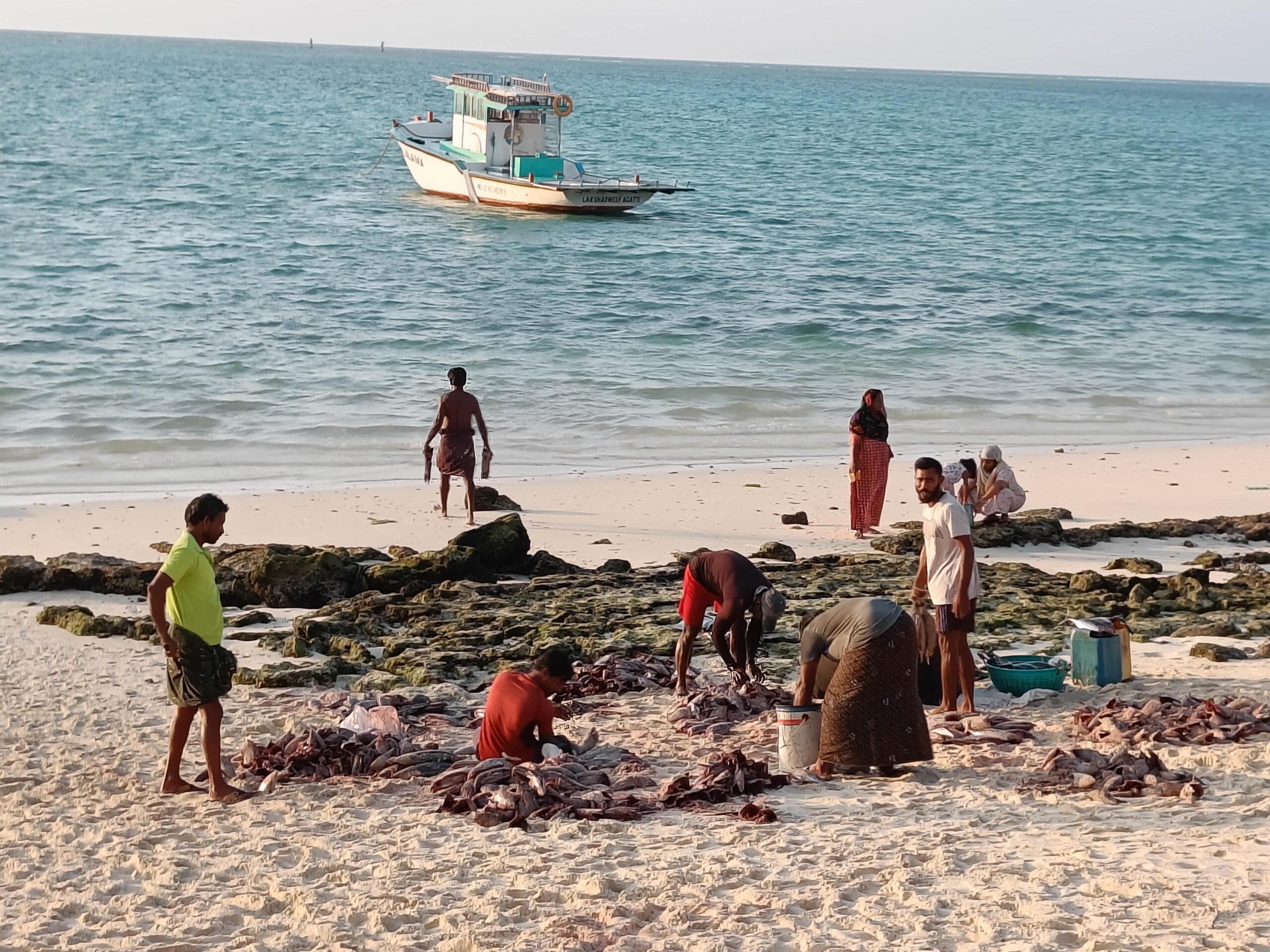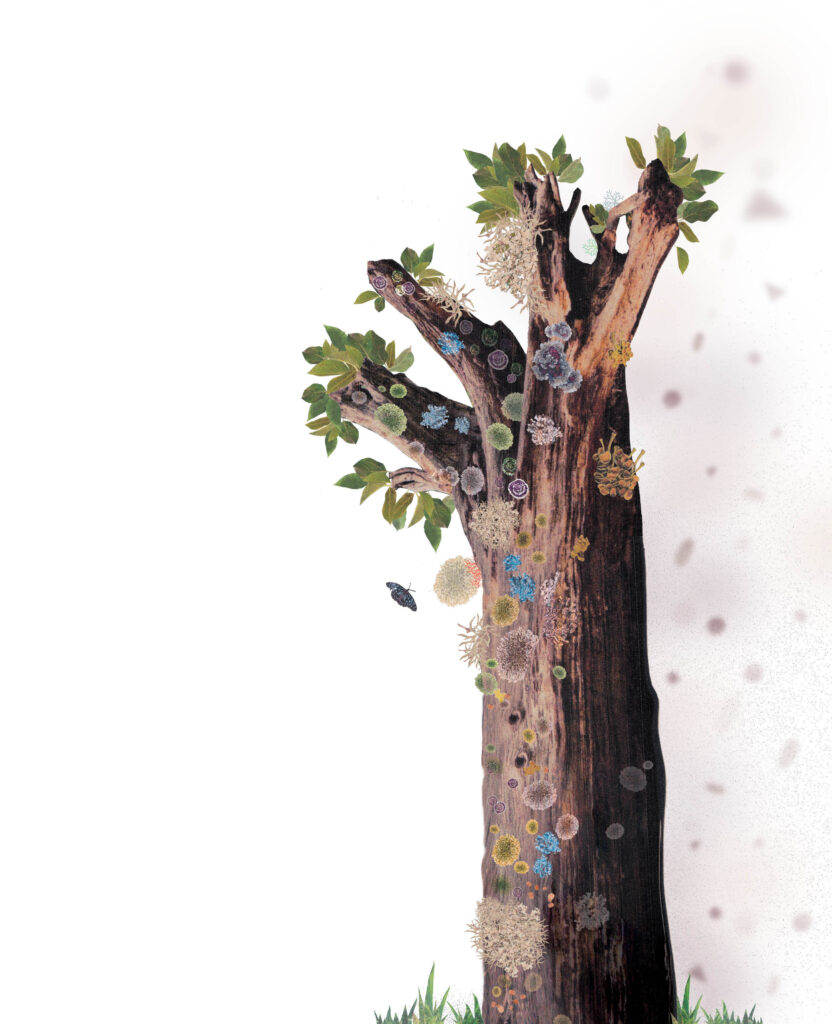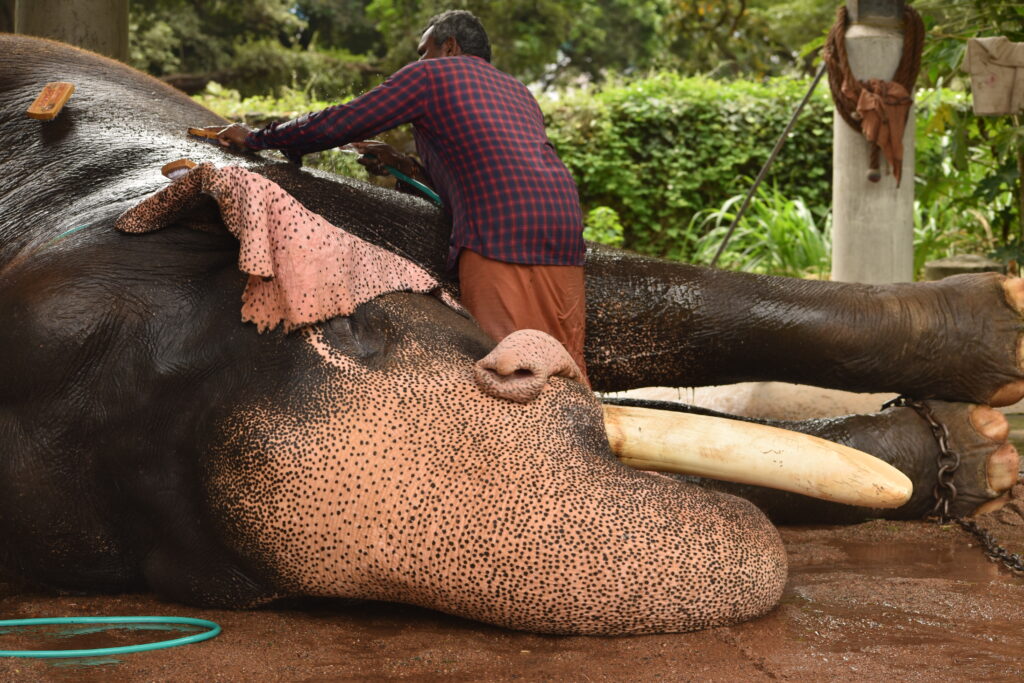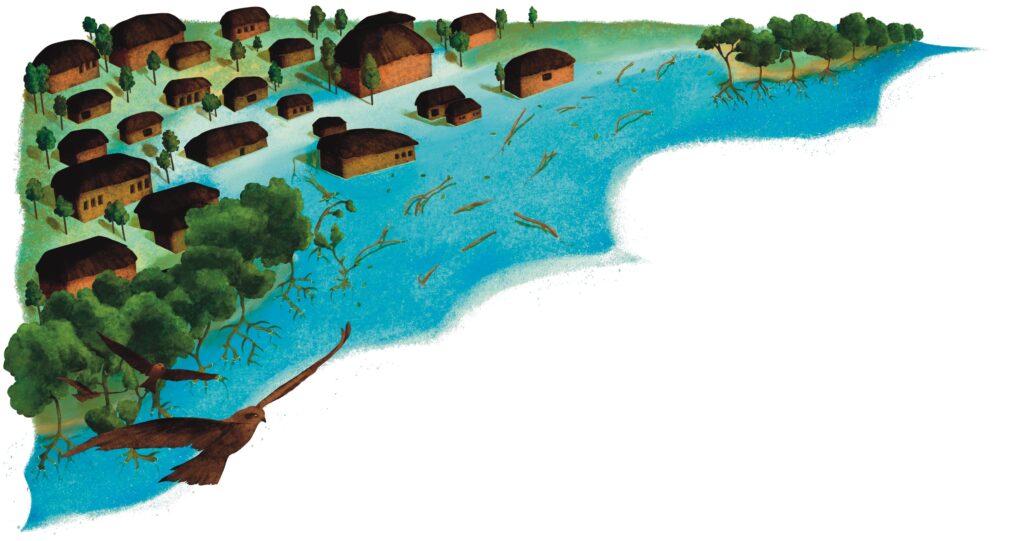Feature image: Landing and cleaning skipjack tuna on the beach
Nearly a century ago, eight fishers from Bitra rowed out to Veliapani. At a shallow channel where Veliapani’s sandy lagoon poured into the sea, they spotted three turtles swimming toward a large boulder, nearly the size of their boat. With harpoons in hand, they watched intently, waiting for the turtles to resurface for air, but they never did. To their astonishment, the boulder stirred; it was not a boulder but a massive, speckled grouper adjusting itself on the sandy bottom. “The grouper could feed the islanders for an entire month,” they thought. It took the strength of all eight men to haul the beast aboard. On gutting the fish, they found the very turtles they had set out to hunt—a double win!
Chalakkad Bitra chronicles this legendary tale in Pullichammam: Maha matsya (spotted grouper: a mighty fish). A resident of Bitra—the smallest fishing community in Lakshadweep, an archipelago of low coral atolls off the southwest coast of mainland India—he offers a glimpse into the lives of old fishers in his novel Odukkadhakal (stories of the odum1), recounting their heroic hunts and travels. These stories depict fishing traditions that predate the arrival of commercial tuna fishing in 1960, which pushed fishers from their familial nearshore waters into the open sea. In Lakshadweep’s folklore, groupers are revered creatures—sentinels of the sea, making men of those who dared catch them.
What was it afraid of?
On a recent dive in Bitra, a large grouper darted across my view, scattering coral shrubbery in its wake. “What was it afraid of?” I wondered. I continued swimming along the contour of the reef while I counted squaretail groupers that had migrated there to spawn. The panic was palpable. Around me, more male squaretails scattered in frantic alarm. Females made a feeble attempt to seek cover from me, their bellies too swollen with eggs for an urgent response.
A year ago, this wasn’t the case; the squaretails when engaged in their feverish courtship, barely noticed my presence. They’d let me approach within arm’s reach, while I took notes about their sex lives on my slate. This year they were noticeably skittish. And it soon became clear why. Above us an engine revved, as a boat pulled up above the site. A small band of fishers dropped like shrapnel into the water. A breath was taken, and a skin diver drew close with a speargun in hand. Before I could react, the large squaretail I was observing was impaled on his speargun.
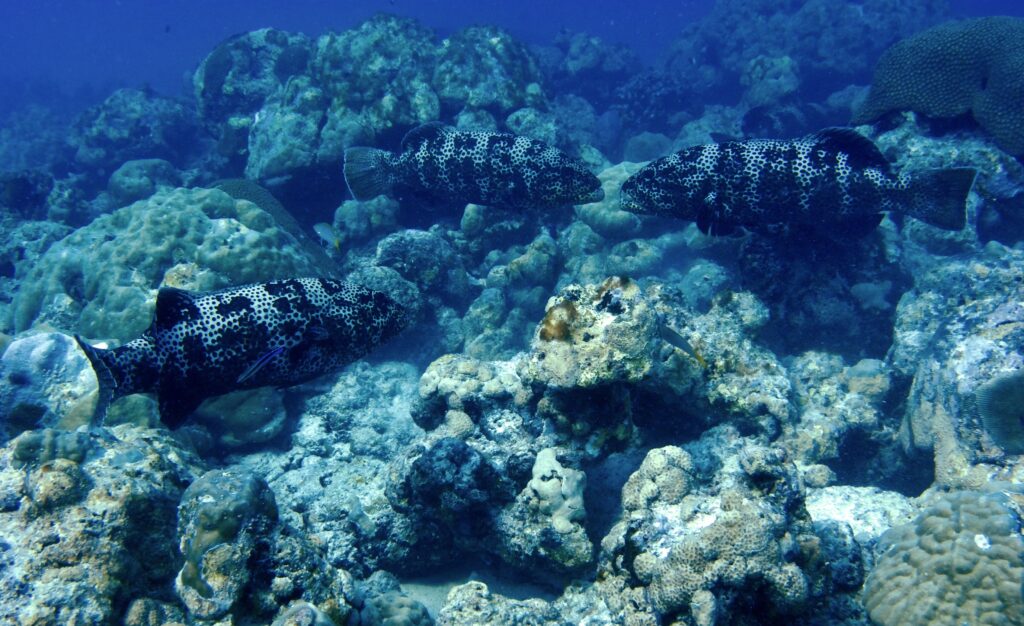
For the past decade, I’ve been studying the ecology of spawning aggregations of squaretail groupers (Plectropomus areolatus) in the reefs of Lakshadweep. Spawning aggregations are extravagant displays of fish behaviour. Each year, when it’s time to spawn, adult fish leave their territories and travel kilometres across the reef to converge at a single location, drawn by a primal urge. Under the shroud of a waning moon, these chosen sites spring to life, as predictably as clockwork.
Year after year, I return with the squaretails, tallying them as they journey to spawn, noting their sizes, sexes, and peculiar mating rituals. By tracking trends in their numbers and differences in behaviour, I can keep a pulse on population health and detect subtle signs of distress. Back in 2013, when I first scoped out this aggregation site for my PhD research, it was a sight to behold—1,200 squaretail groupers milling in an area as vast as a hockey field. But over time, things have changed. The site that once teemed with life now sprawled before me, a desolate expanse. Squaretail numbers had dwindled. Mighty bucks no longer guarded reef territories. Females no longer roamed in grand processions.
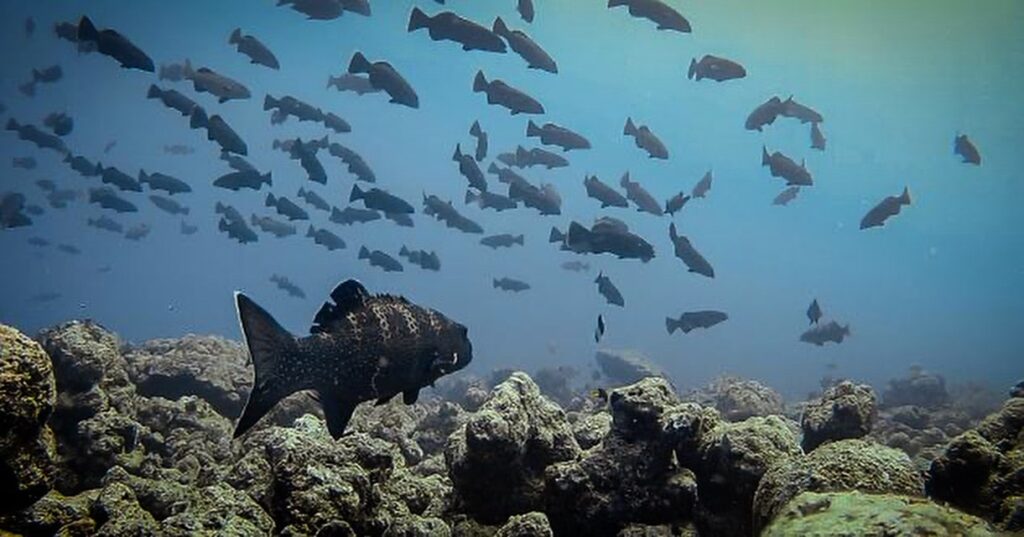
Eighty years after Challakad Bitra’s story, the currents of change are sweeping through island fisheries again, beckoning fishers back to reefs from the open seas. Their gaze is set on prized reef dwellers like groupers, destined for mainland markets. The quest for bounty, largeness, and top predator—hallmarks of an unbridled fishery—has already left an indelible mark on the itinerant squaretails. As I observed their meek, flighty demeanour, I couldn’t help but question their fabled status: what tales would be written about Lakshadweep’s groupers today?
“Groupers are attracted to the eyes”
One of the fishers in the story Pullichammam was Nallakoya’s father. Nallakoya fished like his father did before the arrival of the tuna fishery, reading signs in the weather, tracing constellations and trusting the moods of the sea to guide him. He had just narrated Parava mala a Jeseri2-Arabic ode to the flying fish, an open water fish, traditionally used as bait. Following its instructions, he divided a flying fish into seven parts and, without wasting a piece, caught six small paddletail snappers at the lagoon entrance, where we were anchored.
“Groupers are attracted to the eyes,” he said as he dropped the head of the baitfish into the water. We waited patiently for an hour before there was a familiar tug at his fishing line. Nallakoya had the sea in him, people said—a god-gifted instinct to fish. He scorned the modern anglers who used baitfish caught in the lagoons. The practice of chumming the waters with live baitfish was a technique borrowed from the tuna fishery, its practitioners now redirecting their focus towards the reef. “It’s reckless,” he muttered, his tone tinged with disapproval. “Yellow snappers (the baitfish) often slip away while groupers close in. Harvesting many live baitfish for one grouper is wasteful, when all that is truly needed is a fish head with eyes.”
Near the lagoon crest, I observed another traditional form of reef fishing: a group of elderly fishers hauled an olavadal—a traditional fishing net—into their boat. As it was pulled up, a chain of coconut leaves rustled, concealing a sly gill net beneath. “The whispering of those leaves underwater lures the fish. But unlike the modern fishers, we don’t rob them of their lives, we allow them to sacrifice themselves, and only those who are ready do,” he said, explaining the difference between ‘active’ and ‘passive’ fishing styles of the modern and traditional fishers. With every heave of the olavadal, large parrotfish—vital herbivores in coral reef ecosystems—spilled onto the floor, along with a few gravid squaretails that had sacrificed themselves.
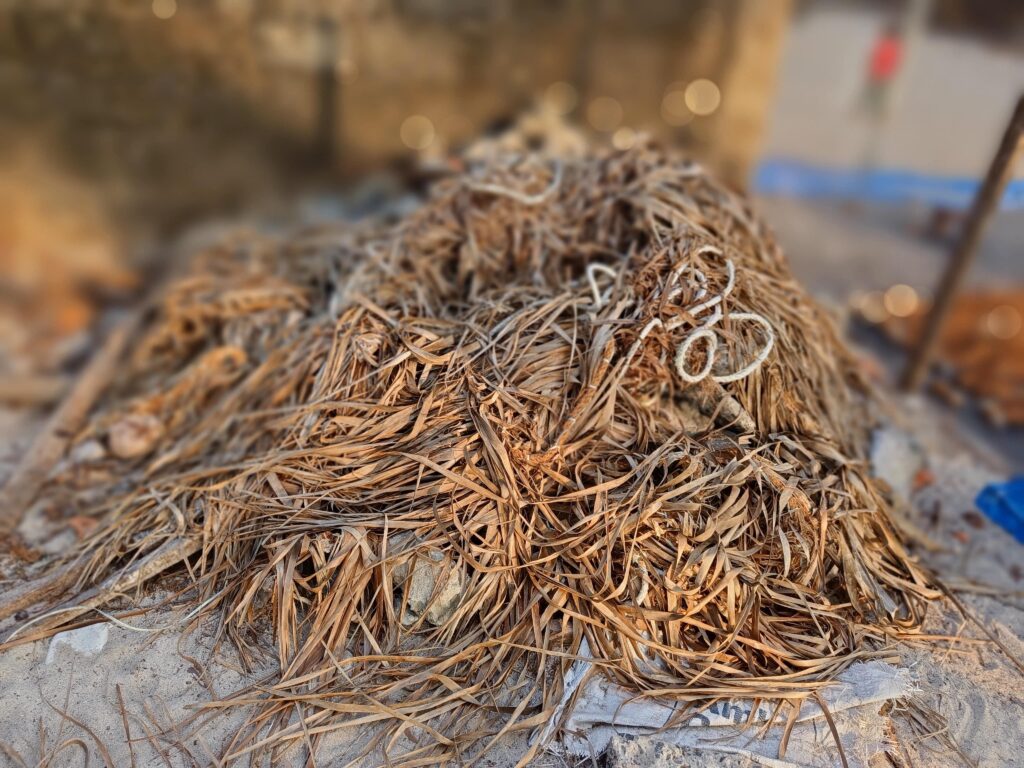
Wastefulness was a growing point of conflict between traditional fishers like Nallakoya and younger modern reef fishers in Lakshadweep. I met some of the modern fishers just days earlier, resurfacing from a solemn dive amid a small flotilla of thonis3. Each thoni was manned by a single fisher that followed their free diving partner around in the water. Curious, I chatted with a pair of them during a surface interval between dives. The team had ‘trolled’ from the lagoon entrance; i.e, the boats had slowly tugged a snorkeler behind them to observe the reef underneath, pausing to explore promising fishing spots, before moving on. As we were speaking, I watched a squaretail emerge out of the water writhing on the blade of a speargun. Within half an hour six others joined its lifeless body by our feet in the thoni. Eight months ago, the young fishers had wielded their first spearguns. Today, they did this job full-time.
The young spearfishers referred to themselves as the kadalkkollakkaar—pirates of the sea. They had recently run into opposition from the traditional fishers in Bitra, who had deemed their practice destructive and took official action against them. “By law, the reefs are communal grounds, are they not? We are fishers too and should be allowed to fish anywhere,” the spearfishers had said when we met. Their words got to the nub of another point of conflict: reefs as commons. The reefs belonged to no one, yet belonged to each and every one, all at once. They were a shared heritage where generations past and present were now colliding.
Ever since this conflagration, the spearfishers felt slandered and chose to operate discreetly in uninhabited atolls like Veliyapani, or under the cover of night. “No one acknowledges the wastefulness of traditional fishing practices. Those nets catch everything in sight. Even the fish that no one eats,” they lamented. “Worse still, the nets can damage coral,” they continued. “We only take what we need, leaving the reef undisturbed,” they assured me. The crew were heading next to Veliyapani with a commercial fish-collection boat from the mainland. I wondered if they’d chance upon an aggregation site there. We exchanged numbers.
Shared knowledge
In my research, I find myself compelled to chronicle the unfolding narrative of the reef fishery in Lakshadweep, as the appetite for reef fish from mainland India surges. I find myself especially intrigued by the local wisdom surrounding reef fish within these fishing communities. The fishers with whom I’ve engaged appear to be coalescing into three discernible fishing groups: the traditionalists, a thinning bunch, who inherit their methods from ancestral wisdom; the modern reef anglers, attuned to the rhythms of the open sea, adapting methods from the tuna fishery; and the spearfishers, a recent addition, acquiring their knowledge through the endless seas of social media. Each group of fishers has their own distinctive blueprint of the reef, with each establishing their own footprint on the waters too.

Nallakoya and the traditionalists held sacred the select locations that aligned with enduring geomorphic features of the atoll—such as chaal, the lagoon entrance; kona, a reef promontory; pitti, a sandpit; bettikedi, the deeper waters of the lagoon. Each site bore a unique name, known to kin, perpetuated through tales like Pullichammam, chronicling their ancestral exploits. While the traditionalists remained loyal to certain locations, modern anglers and spearfishers were less discerning. Their sites were marked as nameless Northings and Eastings on handheld GPS devices, exchanged openly and traversed by all.
Limited by where they fished, the traditionalists felt the pinch, perceiving the biggest changes in their fish catches. “We know exactly when they’ve been here,” Nallakoya remarked, alluding to the nocturnal anglers whose flashlight-lit pursuits disrupt the sleep cycles of fish. “The fish, they cease their biting.” In my conversations with the fishers of Lakshadweep, I sense a melancholic parting of paths. Fathers, sons, uncles, and nephews cling to their own fishing ethos, rarely engaging in mutual dialogue. Were they to do so, they’d see how they sculpt each other’s access to the shared reservoirs of resources. Each carries within them jewels of wisdom, offering pathways to sustainable stewardship of the sea.
I pondered the interplay between this old and new local wisdom and my own scientific understanding of the squaretail groupers, contemplating where these three realms might intersect. I had shared my insights on fish spawning aggregations with Nallakoya and the spearfishers, clarifying a distinction between groupers and tunas, which was a common misunderstanding. While tunas were social creatures, always living in large shoals, groupers were solitary, only gathering sporadically to spawn. This made spawning groupers particularly vulnerable to fishing.
“We didn’t know these fish were laying eggs,” the young fishers had said in response. Nallakoya seemed surprised to hear that some of the squaretails I had examined were over 10 years old. I saw gaps emerging in our collective understanding of seasonality and breeding biology of these fish in the islands. Gaps I earnestly believed were crucial to fill together, to effectively conserve these magnificent fish. A few days later, my phone buzzed. A stream of photos of brown marbled groupers popped up on my screen. The spearfishers had stumbled upon another grouper aggregation site in Veliyapani. I showed it to Nallakoya. He said it was close to the spot where Challakad Bitra had located his story.
“Just like a fish laundry”
In Pullichammam, the grouper is dissected into 640 morsels, each salted and sun-dried, feeding fisher families for a month. Even its sturdy bones find new purpose, fashioned into knives to serve the fishers again. In 2022, after the weary veil of the COVID-19 pandemic had lifted, we strolled along Bitra’s shoreline in the gentle afternoon glow. We saw two familiar faces scaling a bounty of fish. Behind them, fishing lines were strung between wooden poles, where a solitary figure meticulously hung filleted fish to dry. “Like a fish laundry,” my colleague joked, as we watched them billow in the breeze.

Trade with the mainland had ceased for months. In response to the economic hardship facing the community, the Bitra panchayat4 initiated a bold effort to revive an ancient tradition: drying reef fish. Once a monsoon staple, the practice preserved both flavour and nutrients. Bitra, spared from rats and crows, had long led this enterprise, supplying dried fish to neighbouring islands. Such practices predated the rise of the pelagic tuna fishery in the 1960s, which later came to dominate the production and post-harvest fisheries landscape. As I walked along the lines, my gaze fell on rows of squaretails, their once-nimble forms now softly putrefying in the tropical heat. My colleagues busied themselves, packing boxes of dried fish to take home. In the tumultuous wake of the pandemic, as the world grappled with uncertainty, Bitra stayed afloat. The homecoming of spawning fish served as a beacon of hope.
At my desk, a map of Lakshadweep glows softly on my screen. It is adorned with a constellation of coloured dots that mark spawning grounds I’ve now monitored through underwater surveys, and promising locations suggested by fishers that are awaiting further exploration. With each turn of the season, new aggregation sites are being discovered as the fishery extends its grasp. These spawning sites, brimming with their promise of new life, can become crucial lifelines for island fisheries. Their temporal and location-specificity make management efforts concentrated, with benefits to the fishers and the ecosystem permeating far and wide, beyond the confines of the spawning arena.
In distant corners of the globe, spawning grounds have found guardianship under the aegis of the state or the stewardship of local communities. Across the Pacific and Caribbean seas, degraded spawning sites have even experienced a revival with minimal intervention—be it a sporadic fishing moratorium, modest catch limitations, or a communal rotation in harvest responsibilities—offering us glimmers of hope.
However, Nallakoya, the spearfishers, and I are bound together by a shared sense of foreboding. In the absence of urgent and concerted management endeavours, the groupers of Lakshadweep teeter on the brink of a perilous fate. A decade’s worth of tallies of squaretails on my spreadsheet reveals a disquieting downward trend. Spearfishers now find themselves stretching their breaths to capture fewer and more elusive fish within their shooting range, while Nallakoya lingers longer on his boat, amid a sea that seems emptier by the day. Meanwhile, the clamour for groupers from distant shores swells ever louder.
Will the fishers rally together to save the Maha Matsya of their lore? I find myself reflecting on Nallakoya’s words on that tranquil day in the lagoon. There is a difference, he said, between theft and sacrifice. Each leaves a distinct signature on the sea. I think I dimly see the difference, but I’m not quite sure. I often find myself transported back to that moment when I stood utterly spellbound, beholding my first encounter with the squaretail grouper spawning aggregation in the waters of Bitra. Amidst the hustle and bustle at the aggregation site, one male squaretail stood out—a titan amongst his kind, a squaretail grouper of formidable stature who captured my gaze and held it in awe. He staked his territory on the fringes of the site, near a weathered coral boulder nestled in the sand, much like the Maha Matsya. He allowed me to approach within arm’s reach, our gazes locked in a silent exchange, before carrying on with his spawning rituals.
For several years, I saw him in the same spot, and together we forged an unspoken connection in his frenetic world. With each passing year, he looked more weathered, progressively accumulating more battle scars on his body. Then, one year, he appeared with a hook in his lip. He wore it like a trophy. A battle was won, but he was tethered now to our world. The following year, I was in the water when a spearfisher swam down to the reef and speared him through the head, rising to the surface with his writhing body. Was he taken or did he use his agency to surrender to the fisher?
Footnotes:
